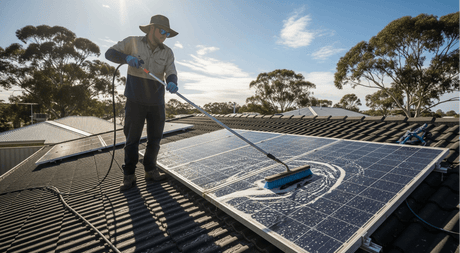If you've ever been out on the water and suddenly had your boat's power cut out, you know it's the fastest way to ruin a perfect day. Nobody wants to be left floating with a dead battery, especially when your boat isn't just transport, but your fishing mate, weekend getaway, or even your little home on the sea.
Here's the thing: your boat's power system relies on one unsung hero - the marine battery.
Now, you might be thinking, “Isn't that just like a car battery?” Not quite. Car batteries are like sprinters, they give you a quick burst of energy to start your engine, then their job's pretty much done. A marine battery, on the other hand, is more like a marathon runner. It's designed to deliver steady, reliable energy over long stretches of time, even when it's rocking around in constant vibration. It powers all your essentials, like your GPS, fishfinder, lights, and radio, without breaking a sweat. And the best part? They're built tough to handle repeated deep discharges, so you can stay out on the water longer without stressing about losing power.
So, what makes these batteries so different, and how do you pick the right one for your boat? Stick around, because in this article, we're diving into everything you need to know to choose the best marine battery for your adventures.
What are Marine Batteries?
A marine battery is designed specifically for boating, and it's very different from the type of battery you'd find in a car. Car batteries just aren't built to cope with the conditions on the water. Boats are exposed to constant vibration, sudden temperature changes between hot days and cool nights, high humidity, and of course, the corrosive effects of saltwater. In that environment, a standard automotive battery will wear out quickly, leaving you without power when you need it most.
Marine batteries, on the other hand, are purpose-built for life on the water. They've got thicker, stronger internal plates and a reinforced design that shrugs off vibration and bumps. Many modern options use smart tech like AGM (Absorbed Glass Mat) or gel construction, which makes them completely sealed. Translation? No messy acid spills, no toxic fumes in enclosed cabins, and no need to fuss with topping up fluids. You can tuck them away in tight spaces without worrying about ventilation, and they're pretty much maintenance-free, set and forget.
The beauty of a good marine battery is how versatile it is. Need a big burst of power to crank over a stubborn outboard at dawn? No worries. Want steady energy for your fishfinder, GPS, lights, and even a sound system while you're trolling or anchored up? It's got your back. They're built tough enough to handle salty, corrosive environments and keep performing whether you're cruising across a glassy bay or smashing through choppy seas.
Types of Marine Batteries
Not all boat batteries are built the same, and picking the right one can make a big difference in how reliable your setup is. Let's break down the main types of marine batteries, what they're best at, and how long you can expect them to last.
Starting Batteries
Think of these as the “jump starters” of the boating world. Their job is simple: deliver a quick, powerful burst of energy to crank your engine over. They're built with thinner plates that make it easy to release energy fast and recharge quickly afterwards. With proper care, you'll usually get 3–4 years out of a starting battery.
Deep Cycle Trolling Motor Batteries
Deep cycle batteries are the workhorses. Instead of giving short bursts, they're designed to supply steady power for longer periods, perfect for things like trolling motors, GPS units, fish finders, lights, and radios. Because they're built with thicker plates, they can handle being discharged and recharged over and over again. Within this category, you've got a few options:
- Flooded Lead-Acid Batteries: The budget-friendly classic. They're widely used, but they do need regular maintenance (like topping up water levels) and good ventilation. Expect around 3–5 years of life if you look after them.
- AGM (Absorbed Glass Mat) Batteries: A step up. These are sealed, spill-proof, and basically maintenance-free. They're also tougher and generally last 4–7 years.
- Lithium Batteries: The premium choice. They're lightweight, super-efficient, charge faster, and can last a massive 8–10 years or more. While the upfront cost is higher, many boat owners find lithium gives the best long-term value.
Dual-Purpose Batteries
If you don't have the space (or budget) to run both a starting battery and a deep cycle battery, a dual-purpose battery can be a handy compromise. They've got enough punch to start your engine and can also keep your electronics running. The trade-off is that they don't perform each job quite as well as a dedicated battery, but for many boaters, it's a solid all-in-one option. Lifespan is usually 3–5 years.
Marine Battery Size and Capacity
Choosing the right marine battery isn't just about picking the biggest one you can find, it's about making sure it fits your boat, matches your power needs, and keeps everything running smoothly when you're out on the water. Let's break it down.
Marine Battery Size
Batteries are grouped into standard “sizes,” which refer to their physical dimensions and capacity. Getting the right size is important, not only because of how much power you need, but also because space on a boat is usually tight.
- Group 24: Around 10.25 x 6.81 x 8.88 inches, with 70–85Ah Great for smaller boats with limited space. They'll happily run your basic electronics and starting needs.
- Group 27: A little bigger at 12.06 x 6.81 x 8.88 inches, with 90–105Ah This is the “all-rounder” size most recreational boaters love, plenty of power for a fish finder, GPS, radio, and LED lights without taking up too much room.
- Group 31: The heavy-duty option at 13 x 6.81 x 9.44 inches, offering 100–125Ah Perfect if you're running trolling motors, multiple electronics, or want longer runtime between charges.
Tip Always measure your battery compartment before buying. A powerful battery that doesn't fit properly isn't just useless, it can actually be unsafe. And don't forget ventilation; even the best batteries need airflow.
Battery Capacity and Power Needs
Capacity is measured in amp-hours (Ah), which tells you how much energy a battery can supply. For example, a 100Ah battery could deliver:
- 100 amps for 1 hour
- 50 amps for 2 hours
- 10 amps for 10 hours
(That's the theory, at least, real-world performance is a bit less perfect.)
Here's a rough idea of how much common boating gear draws:
- LED nav lights: 1–2 amps
- Fish finder: 1–3 amps
- VHF radio: 5–1.5 ampson standby
- GPS unit: 1–2 amps
- Stereo system: 2–8 amps, depending on volume
Now here's the important bit: never drain a deep cycle battery below 50% if you want it to last. That means a 100Ah battery really only gives you about 50Ah of usable energy before you should recharge.
Example: If your gear uses 15 amps and you're out for 6 hours, that's a total of 90Ah needed. With the 50% rule, you'd need at least 180Ah of capacity, which could mean one big battery or a couple of smaller ones linked together.
Other Key Battery Specs
- MCA (Marine Cranking Amps) vs CCA (Cold Cranking Amps): Cars use CCA, measured at freezing temps (0°F). Boats use MCA, measured at 32°F, which is far more relevant here in Australia. Always check MCA when choosing a marine battery.
- Reserve Capacity (RC): This tells you how long a battery can deliver 25 amps at 26°C. In plain English, it shows how long your essentials (like pumps and lights) can keep running if your engine's alternator stops charging. Handy for peace of mind.
Marine Battery Charging Tips and Best Practices
Charging a marine battery isn't quite the same as charging a car battery, and getting it wrong can shorten its life. Car batteries are built to deliver quick bursts of power, while marine batteries (usually deep cycle) are designed for steady energy over long periods. That means they need a gentler, smarter approach to charging.
- Use the Right Charger: First things first: always use a marine battery charger or a smart charger. These are designed with multi-stage charging, which slowly brings your battery up to full without overdoing it. Think of it like cooking something low and slow, it takes a bit longer, but the result is much better. Using a standard car charger might seem convenient, but it can actually overcharge your battery and cut its lifespan short.
- How to Connect the Charger: Attach the positive (red) clamp to the positive terminal.Attach the negative (black) clamp to the negative terminal. Double-check your connections before switching the charger on.
- Set the Right Mode: Most marine batteries are 12V deep cycle, so if your charger has settings, choose the right battery type and voltage. This ensures the charging profile matches what your battery needs.
- Monitor the Charge: Smart chargers are great because they do all the thinking for you, they'll run through the charging stages automatically and switch to a safe maintenance mode once the battery is full. If you're using a simpler charger, you'll need to keep an eye on things. Disconnect it once the battery is charged (a healthy 12V battery should read around 12.6V or higher at rest).
Pro tip: If you want the easiest, most sustainable setup, pair your marine battery with a solar panel system. Solar keeps your battery topped up while you're out on the water, no wall sockets required, and no risk of overcharging with a good solar charge controller. Perfect for longer trips or anyone who loves staying off-grid.
How to Properly Store Marine Batteries for Long-Term Use
If you're packing up the boat for the off-season or just know you won't be using it for a while, giving your marine battery some TLC before storage will save you a lot of headaches later. A well-stored battery will fire up your gear when you need it, instead of leaving you stranded with a dead one. Here's how to do it right:
- Start with a Full Charge: Rule number one: never store a flat battery. Always charge it fully before putting it away. A charged battery is much less likely to suffer from sulfation (that's when crystals build up on the plates and reduce its capacity). It also prevents the electrolyte inside from freezing in colder conditions, which can actually crack the case.
- Disconnect and Detach: Even when the boat's switched “off,” there can still be a small power drain from things like bilge pumps, clocks, or onboard electronics. Over a few months, that's enough to drain your battery completely. The safest option is to disconnect it entirely, or better yet, remove it from the boat and store it separately.
- Pick the Right Spot: Batteries like cool, dry, and well-ventilated environments. Avoid leaving them in direct sun or on cold concrete floors, which can cause damage over time. A wooden shelf, bench, or pallet is ideal. Fun fact: a fully charged battery can handle extreme cold (down to about –56°C), but a half-flat one can actually freeze and be ruined at just 0°C.
- Keep It Topped Up: Even when sitting idle, a battery will slowly lose charge. That's why the best practice is to connect it to a smart charger or trickle charger. These clever devices keep the battery topped up by delivering a tiny maintenance charge when needed, no risk of overcharging, just steady health for the long haul.
Why Choose Renogy Marine Batteries?
When it comes to powering your boat, not all batteries are created equal, and this is where Renogy's Lithium Iron Phosphate (LiFePO4) marine batteries really shine. They're built to give you more power, less weight, and way more flexibility than traditional lead-acid options.
Take the Renogy 12V 100Ah Trolling Motor Battery as an example. Weighing in at just 21.8 pounds (about 9.9 kg), it's less than half the weight of a comparable lead-acid battery. That means your boat handles better, uses less fuel, and performs more efficiently, all without sacrificing power. And because it's built in a compact Group 24 size, it fits neatly into most standard battery compartments.
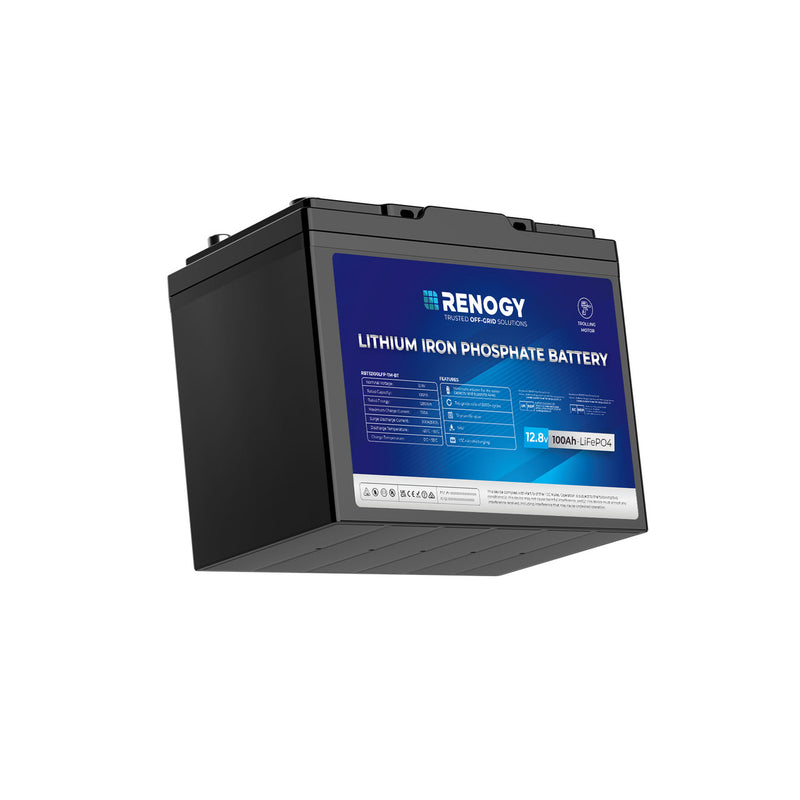
But the real magic is in its versatility. If you need more juice, you can easily link up to four batteries together, in series or parallel. That gives you the freedom to build anything from a simple single-battery setup to a massive 20.48 kWh marine power system. In other words, whether you're running a small trolling motor for a quiet day's fishing or powering a serious off-grid marine setup, Renogy's got you covered.
Lightweight, powerful, and scalable, Renogy LiFePO4 batteries aren't just an upgrade, they're a game-changer for life on the water.
Marine Battery Installation Safety Tips
Installing a marine battery isn't just about plugging it in, it's about making sure it's safe, secure, and ready to perform when you're out on the water. Here are a few key things to keep in mind:
- Secure Mounting: Always use a proper battery box or trayto keep your battery locked in place. Boats bounce around, and an unsecured battery can shift, tip, or even short-circuit in rough seas. Make sure your mounting setup can handle the combined weight if you're running more than one battery.
- Proper Wiring: Use marine-grade wiring that's the correct thickness (gauge) for your setup. Wires that are too thin can overheat and create a fire risk. Keep all connections tight and free of corrosion, it's worth checking them regularly.
- Correct Orientation: Follow the manufacturer's instructions for positioning your battery. Flooded lead-acid batteries, for example, must stay upright to avoid spills. AGM and lithium options are more flexible, but it's always best to double-check.
- Circuit Protection: Never skip fuses or circuit breakers. Installing them between your battery and devices is essential to protect against overloads or short circuits. It's like having a safety switch for your battery system.
- Waterproofing: Marine batteries are built to handle moisture, but giving them extra protection helps extend their life. A dab of dielectric greaseon your connections goes a long way in preventing corrosion.
Maintenance and Care
Like any part of your boat, your marine battery will treat you as well as you treat it. A little maintenance goes a long way towards keeping it healthy, reliable, and long-lasting. Here's how:
- Proper Charging: Charge your battery with a multi-stage smart charger that matches its type (AGM, lithium, etc.). These chargers adjust automatically to avoid overcharging, a major cause of battery damage. And before putting your battery into storage, always top it up to full.
- Cleaning: Corrosion and dirt on your terminals can block proper charging. Check your battery often and clean any buildup with a mix of baking soda and water. Wear protective gloves and glasses, then apply a thin coat of grease after cleaning to stop new corrosion forming.
- Annual Load Test: Once a year, give your battery a proper health check with a load test. This measures how well it holds up under a heavy electrical load. It's the best way to spot a weakening battery before it fails completely, so you can plan a replacement instead of being caught out on the water.
Pro tip: Pairing your marine battery with a solar charging setup is a fantastic way to reduce wear and keep it topped up naturally. Solar is gentle on batteries, extends their lifespan, and means you'll always be ready for your next trip.
FAQs about Marine Batteries
What's the difference between a marine battery and a regular car battery?
A marine battery is designed to do both jobs: give your engine the kick it needs to start and supply steady, long-lasting power to your electronics. Car batteries, on the other hand, are only built for that quick engine start. Marine batteries also have thicker plates and stronger construction so they can handle vibrations, knocks, and deep discharges while you're out on the water.
Can I use a car battery in my boat?
Technically you could, but it's not a good idea. Car batteries aren't built for the repeated deep discharges that boating requires. Use one on your boat and it'll wear out quickly, leaving you without power when you need it most. A proper marine battery will last much longer and give you far more peace of mind.
Is a deep cycle battery the same as a marine battery?
Most marine batteries are deep cycle, which means they're designed to be discharged and recharged over and over without damage. That's exactly what you need for running things like fish finders, lights, GPS, and radios. Some models also come with extra marine-friendly features, like sealed cases and corrosion resistance, for added durability at sea.
Conclusion
Picking the right marine battery isn't just about starting your engine or keeping a few lights on, it's about making sure every trip runs smoothly. From starting batteries to deep cycle and lithium options, each type has its role. Knowing the differences will save you money, hassle, and maybe even a rescue call when you're out on the water.
A few golden rules:
- Choose the right size and capacity for your boat.
- Use a proper marine charger to keep it healthy.
- Store it correctly in the off-season.
- Keep up with simple maintenance checks.
And if you're ready for a real upgrade, Renogy lithium marine batteries are hard to beat. They're lightweight, last for years, and give you the flexibility to power anything from a trolling motor to a full onboard system. In short, they're designed to keep Aussie boaters powered up, whether you're chasing fish, exploring new waters, or just enjoying a day out on the bay.

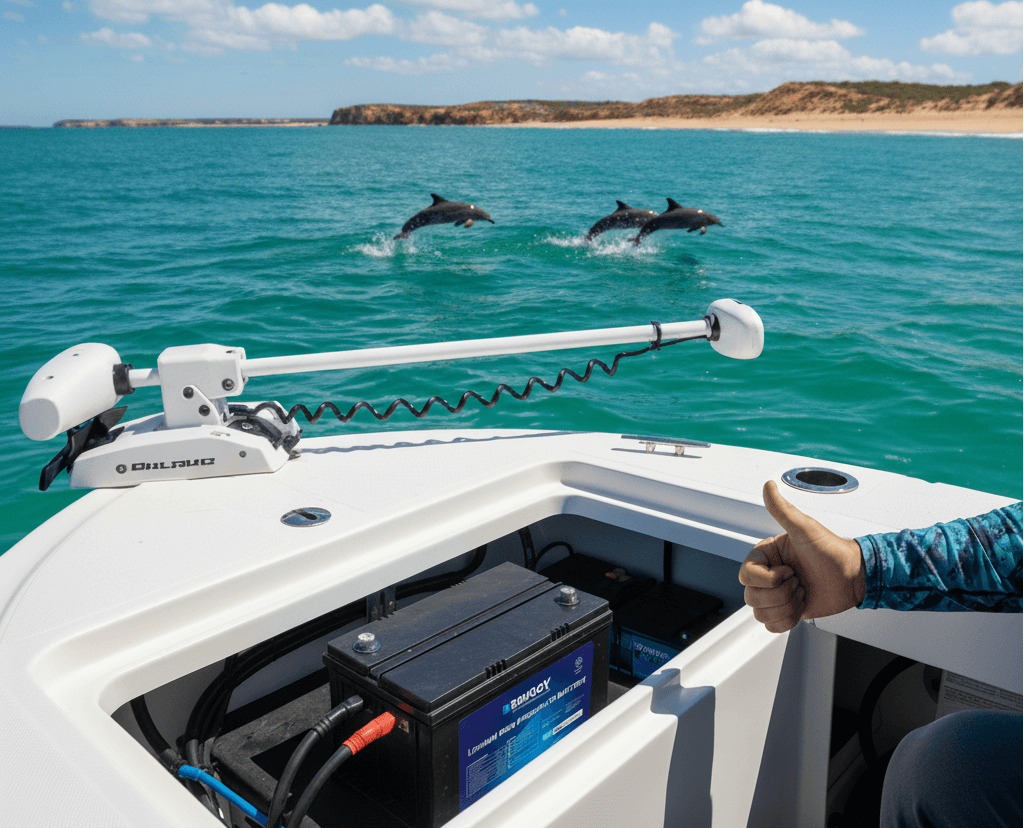



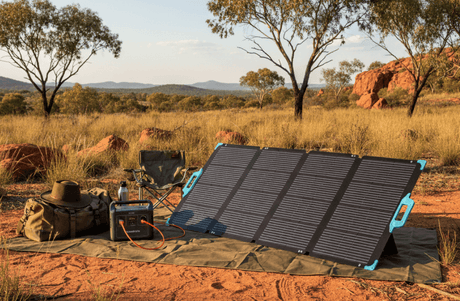
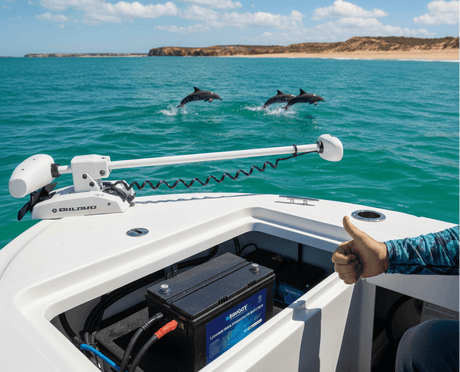
![What Is a DC to DC Battery Charger [Comprehensive Guide]](http://au.renogy.com/cdn/shop/articles/IMG_3829_bd86de74-31d6-49fd-b9d5-265bb723091d.jpg?v=1757582605&width=460)
